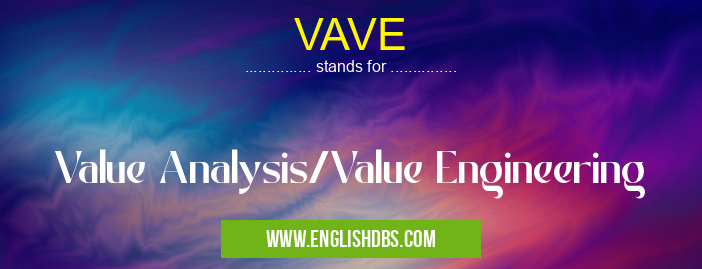What does VAVE mean in ENGINEERING
Value Analysis/Value Engineering (VAVE) is an analytical technique that focuses on the value of product or system. VAVE was first introduced in the 1950s by Lawrence Miles who discovered it as a way to improve products and services while reducing costs, ensuring optimization between offer and cost. VAVE is now widely used by organizations in order to increase value at every step of their product/service life cycle. VAVE applies to all aspects of product/service development from idea generation through design, manufacture, delivery, service and disposal – helping organizations increase their value without sacrificing quality or performance.

VAVE meaning in Engineering in Academic & Science
VAVE mostly used in an acronym Engineering in Category Academic & Science that means Value Analysis/Value Engineering
Shorthand: VAVE,
Full Form: Value Analysis/Value Engineering
For more information of "Value Analysis/Value Engineering", see the section below.
What is VAVE?
VAVE combines techniques such as brainstorming, process mapping, cost analysis and optimization strategies to identify potential sources of improvement and innovation at every stage of product development from concept through design to manufacturing and delivery. The core objective when using VAVE is to reduce costs while maintaining or improving functionality and other performance criteria. For example, this could be achieved by maximizing the use of existing resources like personnel or eliminating unnecessary tasks that add no value to the end-product. This cost reduction allows for greater efficiency which should lead to lower prices, better customer satisfaction rates as well as an increase in profits for the company.
Benefits of Using VAVE
The benefits of using VAVE include improved projects with reduced lead times and faster response times for customers’ needs. Additionally, it helps improve communication between partners in a project team as well as streamline operations throughout the organization since teams can share best practices they have identified during Value Analysis sessions. This can also help organizations become more adaptable when facing changing customer demands or new challenges posed by competitors – increasing their competitive edge in their respective markets.
Essential Questions and Answers on Value Analysis/Value Engineering in "SCIENCE»ENGINEERING"
What is Value Analysis/Value Engineering?
Value Analysis/Value Engineering (VAVE) is a process in which teams analyze the way current products and services are developed and identify opportunities for cost savings, efficiency improvements, and optimization. It employs analytical methods to examine all aspects of product or service production and delivery, from design to manufacturing to installation. VAVE allows companies to uncover hidden value in existing processes and develop new ones that offer significant cost savings without sacrificing quality.
What benefits does Value Analysis/Value Engineering offer?
VAVE helps companies reduce costs while maintaining or even improving product performance by providing an organized methodology for imagining novel design possibilities. Other benefits include improved productivity, shorter development times, reduced errors, better quality control and enhanced customer satisfaction.
How does Value Analysis/Value Engineering work?
In the VAVE process, teams investigate existing products or services to identify potential areas of improvement or cost saving. They then brainstorm creative ways to address these issues through changes in product specifications, designs or production methods. After a number of alternative solutions have been generated and evaluated, the team develops a plan for implementation that includes timelines for each step of the process.
What are the key stages of Value Analysis/Value Engineering?
The main stages of VAVE are problem identification; goal setting; information gathering; analysis; evaluation; selection & implementation; monitoring & review. Each stage is critical to ensuring that new strategies provide successful outcomes with minimal disruption and maximum value.
Is Value Analysis/Value Engineering suitable for all businesses?
The VAVE process can be used by virtually any business wishing to make more efficient use of its resources. However it may not be appropriate for businesses whose goals are focused solely on sales growth rather than cost reduction – although this will depend on their particular circumstances.
Can Value Analysis/Value Engineering help reduce environmental impacts?
Yes – as part of its focus on optimization and innovation, VAVE can help identify opportunities to reduce energy waste and associated environmental impacts during product development, manufacturing or other processes such as distribution or customer service operations.
How long does it take to implement a Value Analysis/Value Engineering project?
This will vary depending on the complexity of the project but typically VAVE projects can be implemented within six months from start-to-finish. Nevertheless there may be ongoing improvements made over time as further potential efficiencies come to light during monitoring reviews.
Does every member of a team need expertise in engineering when using Value Analysis/Value Engineering?
Not necessarily - while engineering knowledge certainly has its role in identifying opportunities for optimization within existing systems, having members who understand different aspects related with production (such as design, supply chain management etc) can also contribute significantly towards successful outcomes.
What techniques are used in Value Analysis/Value Engineering studies?
Techniques such as brainstorming, system mapping, function analysis (FMECA), life cycle costing (LCC), total cost of ownership (TCO) etc are often employed during VAVE projects in order to uncover areas where cost savings can be made without compromising quality standards.
Final Words:
Overall, Value Analysis/Value Engineering (VAVE) provides organizations with an opportunity to reduce costs while maintaining high quality standards and meeting customer demands which should lead to increased profits in return. It is important for organizations to stay up-to-date on their industry trends in order to stay ahead of the competition; one way they can do this is leveraging VAVE tools which will allow them to review processes regularly and make improvements quickly if needed.
